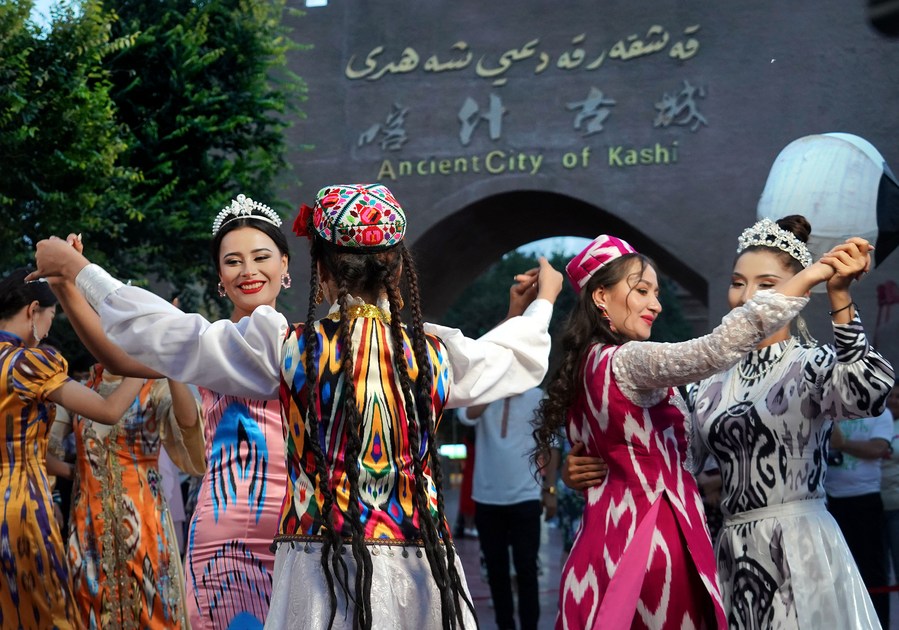A Vibrant Society

By integrating sustainable development, rule of law and human rights protection, Xinjiang is moving quickly to an ideal society characterised by wealth, peace, unity and equity.
Situated in northwest China, Xinjiang Uygur Autonomous Region is the largest provincial region in terms of land area and is endowed with rich resources. It is also known as a champion of China’s reform and opening-up, the core of Silk Road Economic Belt, and a springboard for China’s greater openness.
As a microcosm of the Chinese society that is pursuing greater and faster development, Xinjiang has achieved high-quality growth in its own way.
Before the founding of the People’s Republic of China in 1949, the economy in Xinjiang was mainly based on agriculture and animal husbandry and therefore less productive. There was a lack of railways, big farms or field plots, and industrial firms above a certain size, making it difficult for people to emerge from poverty. After decades of development, things are fundamentally different now.
Focus on development
Following the 18th National Congress of the Communist Party of China (CPC) in 2012, Xi Jinping, General Secretary of the CPC Central Committee, presided over the second and third Central Conference on Work Relating to Xinjiang, and put forward the development strategies for Xinjiang in the new era. He also made two inspection tours there to learn about what people in Xinjiang needed and aspired to.
The government has implemented a series of poverty alleviation projects through industrial development, employment creation, and relocation. Thanks to the efforts of both the government and local people, the per-capita disposable income has been dramatically improved, and Xinjiang now ranks first in terms of the total grain output and the land cultivation area.
Xinjiang has played a vital role in implementing the Belt and Road Initiative. During his inspection in April 2014, President Xi noted that Xinjiang plays an irreplaceable and unique role in the construction of the Silk Road Economic Belt.
Now, 10 years later, Xinjiang, based on its border port, has actively integrated its development into the national overall opening-up strategy to realise win-win cooperation.
Rich in natural and industrial resources, Xinjiang has developed numerous competitive industries with distinctive features. Oil and gas production, organic gardening, green mining and other industries have greatly fuelled the local economy.
Xinjiang is pursuing development in a sustainable way. Tailored measures have been taken to create lush green oases in deserts, setting a good example of harmonious coexistence between human and nature.
Creating a comfortable and happy life for people is the ultimate goal of pursuing high-quality development.

Achieving stable progress
In a world plagued by constant challenges, many economies are stagnant, while China has shown positive growth. Xinjiang has also gained considerable momentum towards high-quality socioeconomic development.
The first reason is related to increasing international cooperation. Xinjiang has always been of strategic importance in China’s development because of its abundant resources, lavish products and constant pursuit of innovation, as well as in the country’s international exchanges because of its geographic location bordering Central Asia, which is close to West Asia and Europe. In the past decade, it has utilised the opportunities presented by the Belt and Road Initiative and has emerged as a vital driver of China’s reform and opening up.
The second reason is related to its people-centred development philosophy. In Xinjiang, everything is done for the people, and everything is done by relying on the people. The most solid basis for Xinjiang’s success and rapid development is to give full play to the initiative, enthusiasm and creativity of people of various ethnic groups. In other words, Xinjiang can gain better and faster development in a stable social environment, and can, in return, consolidate the basis for a long-lasting stable and peaceful society during development.
The third is the implementation of tailored policies and plans to deal with local challenges. Although Xinjiang has abundant resources, enormous development potentials, and vast territory, it also has to struggle with a hostile natural environment marked by insufficient water resources, large areas of desert and desertification, as well as a history of uneven basic education, low education level, inequitable economic growth and outdated ideas. Faced with such problems, the government has implemented different projects based on local conditions to drive local modernisation. Initiatives aimed at empowering people through different forms of education have brought positive outcomes.
The fourth factor is the aid from other places in China. In response to the call of supporting development in Xinjiang, other places in China are supporting the autonomous region through increasing investment, enhancing personnel exchanges and providing sci-tech supports.
Finally, Xinjiang has been unwaveringly following the rule of law in its construction. The rule of law, development and human rights protection are three pillars in local governance. For example, its anti-terrorism actions are legally backed, as stated in the white paper China’s Legal Framework and Measures for Counterterrorism issued by the State Council Information Office on 23 January. Thanks to the efforts of people from all walks of life, the dark clouds of extremism and terrorism are disappearing. Xinjiang has enabled its people a peaceful life, contributing its part to the global fight against terrorism and extremism.
By integrating sustainable development, rule of law and human rights protection, Xinjiang is moving quickly to an ideal society characterised by wealth, peace, unity and equity.
The author is Deputy Director of the Institute of International Law, Chinese Academy of Social Sciences and Vice President of Xinjiang Academy of Social Sciences.
 Facebook
Facebook
 Twitter
Twitter
 Linkedin
Linkedin
 Google +
Google +










